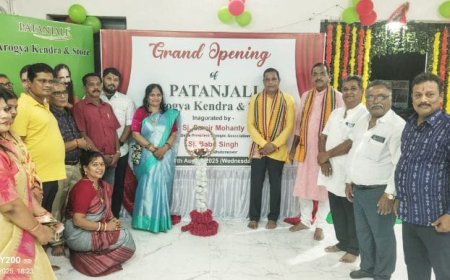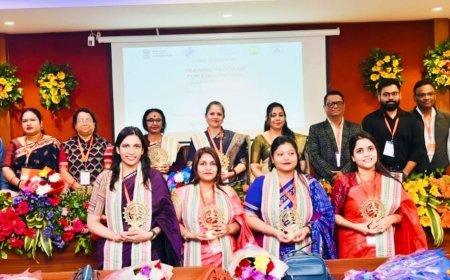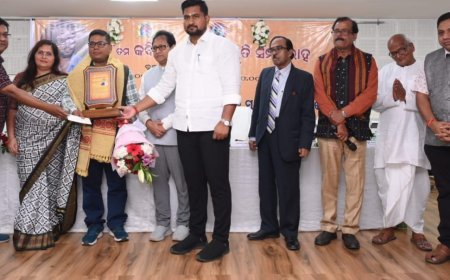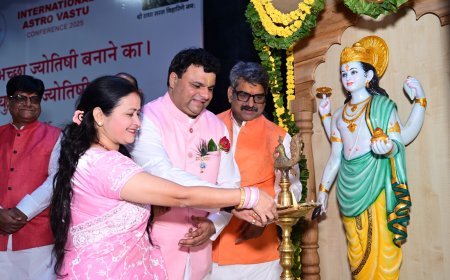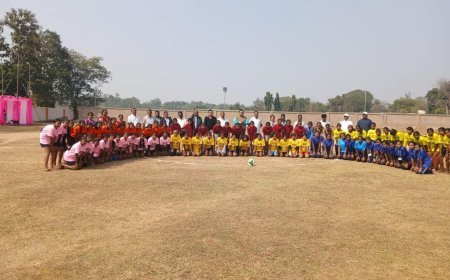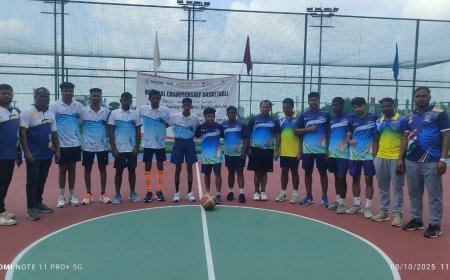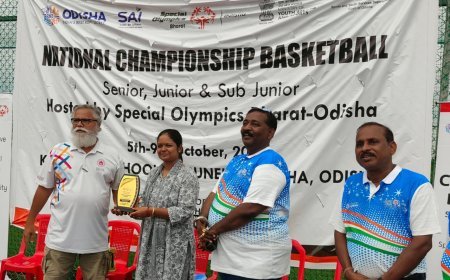Transforming Agriculture: Reliance Foundation’s Push for Millet & Resilient Farming
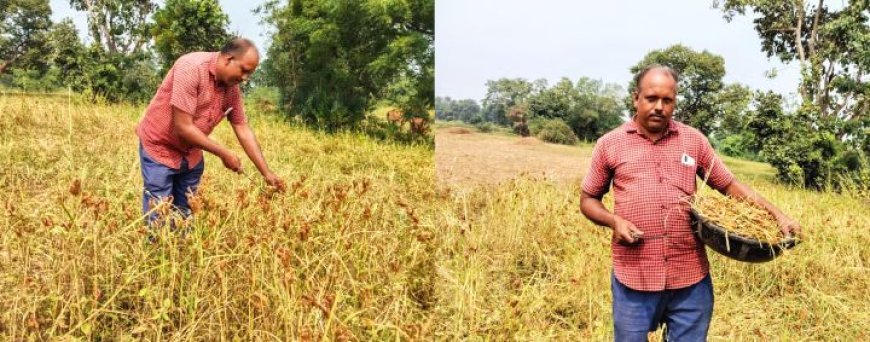
Bhubaneswar(12/12/2024): Odisha, with its diverse agro-climatic zones, is increasingly experiencing the impacts of climate change, from erratic monsoon patterns to rising temperatures.
These shifts have resulted in both drought and flooding events, which compromise traditional crops like paddy.
Farmers across the state, particularly in rainfed districts like Bargarh, face growing uncertainty as these climatic variations affect crop cycles, yields, and ultimately, income stability. The state's average monsoon rainfall in 2024 was 993 mm, with Bargarh receiving a comparable 951 mm.
However, rainfall distribution across the district was uneven, leading to excess moisture in some areas and deficits in others.
For farmers traditionally reliant on water-intensive crops, this inconsistency poses significant risks.
In this context, millet crops known for their drought tolerance and low water requirements present a viable alternative that aligns with both climatic conditions and the state's goals for sustainable agriculture. Millets, including varieties like Ragi (finger millet), are recognized as climate-smart crops due to their adaptability to less fertile soils, resilience against drought, and minimal need for irrigation.
These traits make them particularly suitable for regions facing inconsistent rainfall patterns.
Ragi, for instance, can yield well with moderate rainfall, and its lifecycle matches Odisha’s monsoon distribution, providing food security and income stability in a challenging climate. For Bargarh, where rainfall fluctuates significantly across different blocks, millets offer an efficient solution.
They require minimal inputs, reducing the reliance on external resources and making them financially viable for smallholder farmers.
Additionally, millets are nutrient-rich, helping address nutritional deficiencies among farming communities. Kunal Patel, a 43-year-old farmer from Satidhara village in Bargarh district of Odisha, has been farming for over 20 years.
Born into a family of farmers, Kunal’s passion for agriculture began early, though limited access to education in his village meant he focused on farming rather than pursuing formal studies.
He farms eight acres of land, using six acres for paddy cultivation and one acre for vegetables.
However, the remaining one acre, characterized by its upland nature and lack of irrigation, had remained uncultivated, limiting his income potential and making him dependent on his paddy crop, which was vulnerable to diseases and drought. In March 2024, the Reliance Foundation team visited Satidhara and introduced farmers to a range of services, including digital support, educational programs, and practical field assistance.
Kunal was inspired by the resources available through the Foundation, particularly the Digital Farm School, which offered audio-based learning and field programs.
Motivated to diversify his farming practices, Kunal participated actively in these programs, gaining new insights into sustainable agriculture. The Reliance Foundation, in partnership with KVK Bargarh, provided Kunal with five kilograms of Arjun Ragi seeds.
Ragi, a millet variety, was recommended for its low water requirements and resilience in upland areas.
This opportunity marked Kunal’s first venture into millet cultivation on his previously uncultivated land. Throughout the growing season, Kunal received continued support through the Foundation’s helpline, which provided solutions for pest and disease issues that had plagued his fields in previous years.
Additionally, he became part of a WhatsApp group with over 750 farmers, allowing him to share updates, photos, and queries, and receive timely advice from agricultural experts.
This community support system was instrumental in ensuring the success of his new farming endeavor. By the time of harvest, Kunal’s decision to grow Ragi had proven highly successful.
From his one- acre plot, he harvested 5 quintals of Ragi, earning Rs 21,400 at the MSP price of Rs 4290 per quintal.
This income not only helped recover losses from previous seasons but also provided a new and sustainable revenue stream.
The nutritious Ragi crop added value to Kunal’s family diet, and the diversification of his farm improved his resilience to climate-related challenges. Kunal Patel’s transition to millet cultivation is a prime example of how innovative agricultural practices, supported by community-driven solutions, can empower farmers to overcome limitations and secure their livelihoods.
Through Reliance Foundation’s guidance, Kunal was able to reclaim unused land, diversify his farming activities, and improve his income and food security.
His story offers valuable lessons for farmers facing similar challenges in the region.
Reliance Foundation is actively working to support farmers by promoting the cultivation of nutritious and climate-resilient crops like Finger Millet (Ragi).
Through initiatives like providing Ragi seeds and offering digital support, education, and field assistance, the Foundation helps farmers transition to sustainable farming practices.
Ragi, which requires less water than traditional crops like rice, is ideal for drought-prone areas and upland regions, making it a key tool for climate resilience.
The Foundation’s efforts enable farmers to diversify their crops, improve food security, enhance nutrition, and increase income, while also fostering environmentally sustainable agricultural practices.
In the Kharif season of 2024, Bargarh district received an average rainfall of 951 mm due to the southwest monsoon, supporting agricultural activities across the district.
However, rainfall distribution varied significantly between blocks. Blocks like Gaisilet (686.5 mm), Sohela (739 mm), Bheden (753.4 mm), and Bijepur (854 mm) received below-average rainfall.
These areas may face challenges in maintaining crop yields, as the reduced rainfall could necessitate additional irrigation, impacting water availability and farming costs. In contrast, blocks such as Paikmal (1268.4 mm), Jharbandh (1196.5 mm), and Attabira (1130.1 mm) received substantially higher rainfall, with Paikmal recording the most rainfall in the district.
While this benefits crop growth by ensuring sufficient moisture, excessive rain could also lead to risks like waterlogging and potential flooding in low-lying fields, which might harm crop health. Overall, while the district’s average rainfall was favorable for Kharif crops, especially rice, the varied rainfall across blocks indicates a need for localized water management strategies.
Targeted support may be essential to mitigate risks in high-rainfall areas and to provide irrigation support in areas with lower-than-average rainfall. The 2024 monsoon rainfall distribution in Bargarh district, totaling 951 mm, is favorable for millet cultivation.
Millets are drought-tolerant and thrive with moderate rainfall.
The substantial rain in July (382 mm) and August (349 mm) supports millet seedling establishment and early vegetative growth, while the moderate September rainfall (217 mm) is ideal for flowering and grain filling, avoiding excess moisture that could harm the crop. By October, rainfall drops to just 3 mm, aligning well with the ripening and harvesting stages, minimizing the risk of grain damage from high moisture.
This distribution not only meets millet’s water needs but also reduces vulnerability to pests and diseases common with wetter conditions. Odisha’s rainfall pattern supports millet as a climate-resilient crop, fitting well into Odisha’s goals for sustainable agriculture.
This makes it an ideal region for millet, which requires moderate moisture for growth and dry conditions at harvest.
It will be more suitable for the unirrigated upland situations. As climate change brings more frequent droughts and erratic rainfall patterns, millet crops are proving to be climate-resilient alternatives.
Unlike paddy, which demands consistent water, millets can thrive on limited rainfall, making them suitable for areas with unreliable water sources.
This shift supports food security and enhances income stability for farmers, aligning with Odisha’s goals for sustainable agriculture. The 2024 Kharif season in Bargarh highlights the growing importance of millet in Odisha’s agricultural landscape.
With changing climate patterns, traditional crops face challenges that can be mitigated by cultivating climate-resilient crops like millet.
Kunal Patel’s journey underscores how millet cultivation can reclaim fallow lands, improve financial stability, and enhance nutrition—all while supporting Odisha’s vision for sustainable and climate-smart agriculture. Millet has transformed from being an undervalued crop to a powerful tool for resilience and sustainability in Bargarh and across Odisha.
As more farmers adopt this resilient crop, a shift towards diversified, climate-adaptive farming systems becomes achievable, paving the way for a future where Odisha’s agriculture is not only sustainable but also thriving amidst climate uncertainties.








